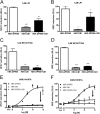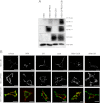The cannabinoid receptor CB1 modulates the signaling properties of the lysophosphatidylinositol receptor GPR55
- PMID: 23161546
- PMCID: PMC3531739
- DOI: 10.1074/jbc.M112.364109
The cannabinoid receptor CB1 modulates the signaling properties of the lysophosphatidylinositol receptor GPR55
Abstract
The G protein-coupled receptor (GPCR) 55 (GPR55) and the cannabinoid receptor 1 (CB1R) are co-expressed in many tissues, predominantly in the central nervous system. Seven transmembrane spanning (7TM) receptors/GPCRs can form homo- and heteromers and initiate distinct signaling pathways. Recently, several synthetic CB1 receptor inverse agonists/antagonists, such as SR141716A, AM251, and AM281, were reported to activate GPR55. Of these, SR141716A was marketed as a promising anti-obesity drug, but was withdrawn from the market because of severe side effects. Here, we tested whether GPR55 and CB1 receptors are capable of (i) forming heteromers and (ii) whether such heteromers could exhibit novel signaling patterns. We show that GPR55 and CB1 receptors alter each others signaling properties in human embryonic kidney (HEK293) cells. We demonstrate that the co-expression of FLAG-CB1 receptors in cells stably expressing HA-GPR55 specifically inhibits GPR55-mediated transcription factor activation, such as nuclear factor of activated T-cells and serum response element, as well as extracellular signal-regulated kinases (ERK1/2) activation. GPR55 and CB1 receptors can form heteromers, but the internalization of both receptors is not affected. In addition, we observe that the presence of GPR55 enhances CB1R-mediated ERK1/2 and nuclear factor of activated T-cell activation. Our data provide the first evidence that GPR55 can form heteromers with another 7TM/GPCR and that this interaction with the CB1 receptor has functional consequences in vitro. The GPR55-CB1R heteromer may play an important physiological and/or pathophysiological role in tissues endogenously co-expressing both receptors.
Figures









References
-
- Matsuda L. A., Lolait S. J., Brownstein M. J., Young A. C., Bonner T. I. (1990) Structure of a cannabinoid receptor and functional expression of the cloned cDNA. Nature 346, 561–564 - PubMed
-
- Munro S., Thomas K. L., Abu-Shaar M. (1993) Molecular characterization of a peripheral receptor for cannabinoids. Nature 365, 61–65 - PubMed
-
- Pertwee R. G., Howlett A. C., Abood M. E., Alexander S. P., Di Marzo V., Elphick M. R., Greasley P. J., Hansen H. S., Kunos G., Mackie K., Mechoulam R., Ross R. A. (2010) International Union of Basic and Clinical Pharmacology. LXXIX. Cannabinoid receptors and their ligands. Beyond CB1 and CB2. Pharmacol. Rev. 62, 588–631 - PMC - PubMed
-
- Tsou K., Brown S., Sañudo-Peña M. C., Mackie K., Walker J. M. (1998) Immunohistochemical distribution of cannabinoid CB1 receptors in the rat central nervous system. Neuroscience 83, 393–411 - PubMed
Publication types
MeSH terms
Substances
Grants and funding
LinkOut - more resources
Full Text Sources
Research Materials
Miscellaneous

